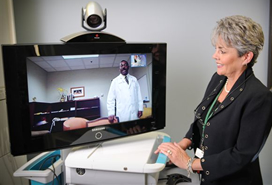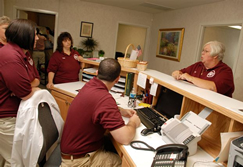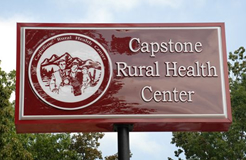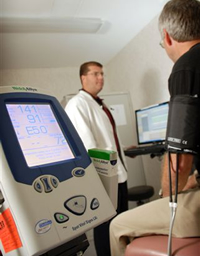From Remote Monitoring of Truckers’ Vitals to Mental Health Consultations via Video, Researchers Extend Care through Technology

There’s easy access, and then there’s easy access. In 2001, the Capstone Rural Health Center opened in Parrish, bringing quality health care near to the doorsteps of the approximate 1,500 people living in and around the rural Walker County, Ala. community. Today, the Center’s reach extends well beyond the tiny town’s borders. In fact, some of those whose health conditions are soon to be closely and regularly monitored by the clinic’s nurses will be working hundreds of miles away. Remote monitoring equipment – made possible by telehealth technology, and, in this case, a research grant to the Center’s executive director, Dr. Jeri Dunkin – will transmit vital health care information directly from the cabs of some 10 long-haul truck drivers to computers monitored by the center’s nurses. Dunkin, who holds the Saxon Chair for Rural Nursing in UA’s Capstone College of Nursing, proposed the research as a potential method for improving trucker health, cutting insurance costs and potentially reducing accidents. LONG ARM OF TELE-HEALTH Truckers in the study, all volunteers, will have their blood pressure and blood sugar levels monitored while they are on the road. Computer systems in the truckers’ cabs will transmit readings wirelessly to a secure Web site monitored by the clinic’s nurses. “They are a population that is very vulnerable for health incidents,” Dunkin says of truckers. “Heart disease and diabetes are two of the leading health problems in the country, and they are also big problems in truck drivers.” A sedentary job, like truck driving, one which also can make eating nutritional meals challenging, can accentuate health problems, researchers say. Because of truckers’ daily and sometimes lengthy travels, it can also typically be difficult for them to visit their health care providers for regular monitoring. So, Dunkin, thanks to a $94,500 grant within the Labor, Health and Human Services and Education budget, is bringing the monitoring system directly into the truckers’ cabs. Truckers who are agreeable to such monitoring are already exhibiting the first step in adjusting to a more health conscious lifestyle, Dunkin says. “If they are willing to do that, they are willing to change their health habits,” Dunkin says. “They just need a little help.” That’s a long-term goal and, in the short-term, if a trucker has a dangerously high health reading, the nurses can contact him via cell phone and alert him to get off the road and seek immediate medical attention. REMOTE READINGS

This won’t be the clinic’s first foray into telehealth related efforts. The nurse-managed center has established kiosks in two mental health group homes and one day program setting, allowing the monitoring of up to 40 residents’ health issues, including their weights, blood oxygen and glucose levels. About 10 additional Walker County residents, who receive their primary health care through the Capstone Rural Health Center, will soon have in-home monitoring systems in place as well. And while it might seem surprising to see such telehealth related initiatives emanating from a clinic based in a rural Alabama town, it’s not so unexpected coming from this specific clinic. The Capstone Rural Health Center has been quick to embrace technology and is already part of an estimated 4 percent of medical practices in the U.S. to have a fully functional electronic medical record system. HIGH DEF ENABLES ‘READING’ OF BODY LANGUAGE FROM AFAR

More telemedicine projects are popping up in the College of Engineering and the College of Community Health Sciences. For example, CCHS is reaching out with telemedicine to five rural Alabama counties to help mental-health professionals treat patients. The program, run through the West Alabama Mental Health Center, will use Internet technology and T1 lines directly linked to mental-health centers to bring patients into real-time contact with UA psychiatrists. The psychiatrist in Tuscaloosa gets to see and interact with the patient in the rural setting who may have a problem the local therapist may need help in treating. “We can offer consultations to other professionals who need a quick, efficient connection with other specialists,” says Dr. Thaddeus P. Ulzen, chair of psychiatry and behavioral medicine at CCHS. “They don’t have to drive here, and we don’t have to drive there.” The big advantage of a high-definition video link is that psychiatrists can “read” body language and establish a strong connection with the patient in the rural setting. “You’re interested in the emotions the person expresses and also any behavioral issues you can observe,” Ulzen says. “It’s almost the same as if they were in your office.” In the future, CCHS staff members hope to expand telemedicine offerings to help train medical students in the technology and also using the technology to train health professionals in the field. For example, a rural doctor in Livingston or other Alabama locations could get on a live video Internet hookup with a professional in Tuscaloosa to consult on a patient who’s in his office, says Joe Higginbotham, assistant director of information technology at CCHS. Another possibility would be live training of emergency technicians and doctors in a 14-county Alabama region, all in real time from Tuscaloosa, Higginbotham says. DEVELOPING WIRELESS MONITORING OF CARDIAC PATIENTS Meanwhile, Dr. Yang Xiao, assistant professor of computer science at UA, and a colleague, Dr. Fei Hu, of the Rochester Institute of Technology, were awarded a $400,000 grant from the National Science Foundation’s Cyber Trust Program to research advancements in wireless telemedicine. Xiao is working on the integration of radio frequency identification technology, also known as RFID, into cardiac system networks. These networks remotely monitor and transfer a patient’s heartbeat and blood pressure to doctors off-site to improve medical care awareness and availability. The team hopes that the study will lead to a significant increase in the quality of medical care, a decrease in health care costs for patients, and a substantial improvement in medical diagnosis. “The integration of RFID into existing cardiac systems can monitor the medicine taking behavior of the patients, preventing them from taking too much or the wrong kind of medicine” Xiao says. “In addition, the integration can monitor the location of patients who are experiencing medical emergencies, like strokes or heart attacks.” CENTER STARTED DOWN E-RECORD SYSTEM PATH IN ‘04 Those with the Capstone Rural Health Center in Parrish know a thing or three about integrating a new system.

The clinic began using an electronic medical records system in 2004, says David Jones, one of two nurse practitioners who provide primary care at the clinic. The system, Jones says, improves patient safety, reduces potential for medical records and allows more time to be spent with patients. Computers are present in exam rooms, enabling the nurse practitioners to chart electronically alongside their patients. “We do everything right alongside the patient,” Jones says. “The patients feel a better sense of involvement in their care when we can work through the documentation with them.” Entering patients’ vitals directly into the electronic system, which also contains patients’ medical histories, reduces the chances of error that can sometimes occur if transferring from a paper chart, Jones says. The system also allows both lab orders and prescription orders to be placed electronically via computer, and lab results are later returned to the clinic’s secure system. Correspondence between the clinic and insurance providers, including Medicare, are also handled electronically. Dunkin envisions the clinic becoming completely paperless by December. In this way, in addition to the primary advantage of providing improved health care, Dunkin says the effort makes the clinic more environmentally friendly and even better utilizes office work space. “We could accommodate another person in the office if we didn’t have those eight filing cabinets in there.” Chris Bryant, Richard LeComte, Allison Bridges and Mary Wymer contributed to this report. Further Reading